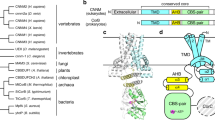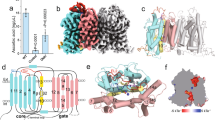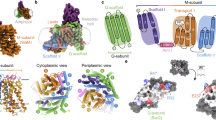Abstract
The nucleobase/ascorbate transporter (NAT) proteins, also known as nucleobase/cation symporter 2 (NCS2) proteins, are responsible for the uptake of nucleobases in all kingdoms of life and for the transport of vitamin C in mammals1,2. Despite functional characterization of the NAT family members in bacteria, fungi and mammals, detailed structural information remains unavailable. Here we report the crystal structure of a representative NAT protein, the Escherichia coli uracil/H+ symporter UraA, in complex with uracil at a resolution of 2.8 Å. UraA has a novel structural fold, with 14 transmembrane segments (TMs) divided into two inverted repeats. A pair of antiparallel β-strands is located between TM3 and TM10 and has an important role in structural organization and substrate recognition. The structure is spatially arranged into a core domain and a gate domain. Uracil, located at the interface between the two domains, is coordinated mainly by residues from the core domain. Structural analysis suggests that alternating access of the substrate may be achieved through conformational changes of the gate domain.
This is a preview of subscription content, access via your institution
Access options
Subscribe to this journal
Receive 51 print issues and online access
$199.00 per year
only $3.90 per issue
Buy this article
- Purchase on Springer Link
- Instant access to full article PDF
Prices may be subject to local taxes which are calculated during checkout




Similar content being viewed by others
Change history
14 April 2011
In the Fig. 4b legend, Glu245 was corrected to Glu290.
References
Saier, M. H., Jr et al. Phylogenetic characterization of novel transport protein families revealed by genome analyses. Biochim. Biophys. Acta 1422, 1–56 (1999)
Gournas, C., Papageorgiou, I. & Diallinas, G. The nucleobase-ascorbate transporter (NAT) family: genomics, evolution, structure-function relationships and physiological role. Mol. Biosyst. 4, 404–416 (2008)
Tsukaguchi, H. et al. A family of mammalian Na+-dependent l-ascorbic acid transporters. Nature 399, 70–75 (1999)
Wang, Y. et al. Human vitamin C (l-ascorbic acid) transporter SVCT1. Biochem. Biophys. Res. Commun. 267, 488–494 (2000)
Savini, I., Rossi, A., Pierro, C., Avigliano, L. & Catani, M. V. SVCT1 and SVCT2: key proteins for vitamin C uptake. Amino Acids 34, 347–355 (2008)
Yamamoto, S. et al. Identification and functional characterization of the first nucleobase transporter in mammals: implication in the species difference in the intestinal absorption mechanism of nucleobases and their analogs between higher primates and other mammals. J. Biol. Chem. 285, 6522–6531 (2010)
Diallinas, G. & Scazzocchio, C. A gene coding for the uric acid-xanthine permease of Aspergillus nidulans: inactivational cloning, characterization, and sequence of a cis-acting mutation. Genetics 122, 341–350 (1989)
Karatza, P. & Frillingos, S. Cloning and functional characterization of two bacterial members of the NAT/NCS2 family in Escherichia coli . Mol. Membr. Biol. 22, 251–261 (2005)
Andersen, P. S., Frees, D., Fast, R. & Mygind, B. Uracil uptake in Escherichia coli K-12: isolation of uraA mutants and cloning of the gene. J. Bacteriol. 177, 2008–2013 (1995)
Koukaki, M. et al. The nucleobase-ascorbate transporter (NAT) signature motif in UapA defines the function of the purine translocation pathway. J. Mol. Biol. 350, 499–513 (2005)
Karatza, P., Panos, P., Georgopoulou, E. & Frillingos, S. Cysteine-scanning analysis of the nucleobase-ascorbate transporter signature motif in YgfO permease of Escherichia coli: Gln-324 and Asn-325 are essential, and Ile-329–Val-339 form an α-helix. J. Biol. Chem. 281, 39881–39890 (2006)
Georgopoulou, E., Mermelekas, G., Karena, E. & Frillingos, S. Purine substrate recognition by the nucleobase-ascorbate transporter signature motif in the YgfO xanthine permease: Asn-325 binds and Ala-323 senses substrate. J. Biol. Chem. 285, 19422–19433 (2010)
de Koning, H. & Diallinas, G. Nucleobase transporters. Mol. Membr. Biol. 17, 75–94 (2000)
Weyand, S. et al. Structure and molecular mechanism of a nucleobase-cation-symport-1 family transporter. Science 322, 709–713 (2008)
Shimamura, T. et al. Molecular basis of alternating access membrane transport by the sodium-hydantoin transporter Mhp1. Science 328, 470–473 (2010)
Yamashita, A., Singh, S. K., Kawate, T., Jin, Y. & Gouaux, E. Crystal structure of a bacterial homologue of Na+/Cl–dependent neurotransmitter transporters. Nature 437, 215–223 (2005)
Quick, M. et al. Binding of an octylglucoside detergent molecule in the second substrate (S2) site of LeuT establishes an inhibitor-bound conformation. Proc. Natl Acad. Sci. USA 106, 5563–5568 (2009)
Holm, L. & Rosenström, P. Dali server: conservation mapping in 3D. Nucleic Acids Res. 38, W545–W549 (2010)
Screpanti, E. & Hunte, C. Discontinuous membrane helices in transport proteins and their correlation with function. J. Struct. Biol. 159, 261–267 (2007)
Fu, D. et al. Structure of a glycerol-conducting channel and the basis for its selectivity. Science 290, 481–486 (2000)
Wang, Y. et al. Structure of the formate transporter FocA reveals a pentameric aquaporin-like channel. Nature 462, 467–472 (2009)
Faham, S. et al. The crystal structure of a sodium galactose transporter reveals mechanistic insights into Na+/sugar symport. Science 321, 810–814 (2008)
Ressl, S., Terwisscha van Scheltinga, A. C., Vonrhein, C., Ott, V. & Ziegler, C. Molecular basis of transport and regulation in the Na+/betaine symporter BetP. Nature 458, 47–52 (2009)
Fang, Y. et al. Structure of a prokaryotic virtual proton pump at 3.2 Å resolution. Nature 460, 1040–1043 (2009)
Gao, X. et al. Mechanism of substrate recognition and transport by an amino acid antiporter. Nature 463, 828–832 (2010)
Smart, O. S., Goodfellow, J. M. & Wallace, B. A. The pore dimensions of gramicidin A. Biophys. J. 65, 2455–2460 (1993)
Otwinowski, Z. & Minor, W. Processing of X-ray diffraction data collected in oscillation mode. Methods Enzymol. 276, 307–326 (1997)
Terwilliger, T. C. & Berendzen, J. Automated MAD and MIR structure solution. Acta Crystallogr. D 55, 849–861 (1999)
Adams, P. D. et al. PHENIX: building new software for automated crystallographic structure determination. Acta Crystallogr. D 58, 1948–1954 (2002)
DeLano, W. L. PyMOL Molecular Viewer 〈http://www.pymol.org〉 (2002)
Collaborative Computational Project, Number 4. The CCP4 suite: programs for protein crystallography. Acta Crystallogr. D 50, 760–763 (1994)
Cowtan, K. DM: an automated procedure for phase improvement by density modification. Joint CCP4 ESF-EACBM Newslett. Protein Crystallogr. 31, 34–38 (1994)
Emsley, P. & Cowtan, K. Coot: model-building tools for molecular graphics. Acta Crystallogr. D 60, 2126–2132 (2004)
Scheich, C., Kummel, D., Soumailakakis, D., Heinemann, U. & Bussow, K. Vectors for co-expression of an unrestricted number of proteins. Nucleic Acids Res. 35, e43 (2007)
Dang, S. et al. Structure of a fucose transporter in an outward-open conformation. Nature 467, 734–738 (2010)
Acknowledgements
We thank N. Shimizu at the Spring-8 beamline BL41XU, and J. He and S. Huang at the Shanghai Synchrotron Radiation Facility for on-site assistance. We thank Y. Shi and Y. Yan for critical discussions. This work was supported by funds from the Ministry of Science and Technology (grant numbers 2009CB918802 and 2011CB910501), Tsinghua University 985 Phase II funds and Project 91017011 supported by the National Natural Science Foundation of China. N.Y. acknowledges support from the Yuyuan Foundation and the Li Foundation.
Author information
Authors and Affiliations
Contributions
F.L., S.L., Y.J., J.J., H.F., G.L. and N.Y. designed all experiments. F.L., S.L., Y.J., J.J., H.F., G.L., D.D., S.D. and X.Z. performed the experiments. All authors analysed the data. F.L., J.W. and N.Y. contributed to manuscript preparation. N.Y. wrote the manuscript.
Corresponding author
Ethics declarations
Competing interests
The authors declare no competing financial interests.
Supplementary information
Supplementary Information
The file contains Supplementary Figures 1-8 with legends and Supplementary Table 1. (PDF 2170 kb)
Rights and permissions
About this article
Cite this article
Lu, F., Li, S., Jiang, Y. et al. Structure and mechanism of the uracil transporter UraA. Nature 472, 243–246 (2011). https://doi.org/10.1038/nature09885
Received:
Accepted:
Published:
Issue Date:
DOI: https://doi.org/10.1038/nature09885
This article is cited by
-
Mechanism of anion exchange and small-molecule inhibition of pendrin
Nature Communications (2024)
-
Structural basis of vitamin C recognition and transport by mammalian SVCT1 transporter
Nature Communications (2023)
-
TTYH family members form tetrameric complexes at the cell membrane
Communications Biology (2022)
-
Cryo-EM structures of thermostabilized prestin provide mechanistic insights underlying outer hair cell electromotility
Nature Communications (2022)
-
Single particle cryo-EM structure of the outer hair cell motor protein prestin
Nature Communications (2022)
Comments
By submitting a comment you agree to abide by our Terms and Community Guidelines. If you find something abusive or that does not comply with our terms or guidelines please flag it as inappropriate.



